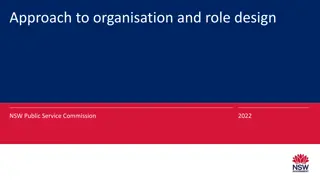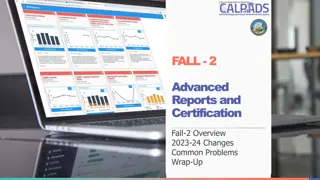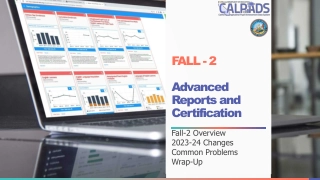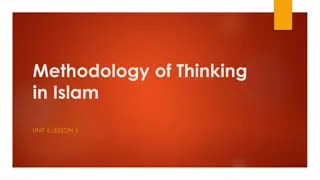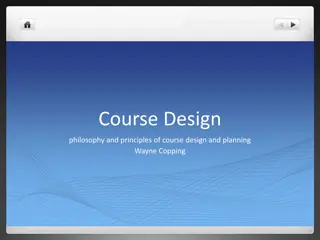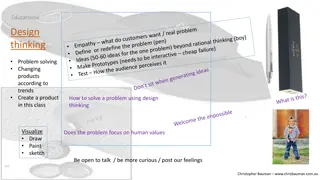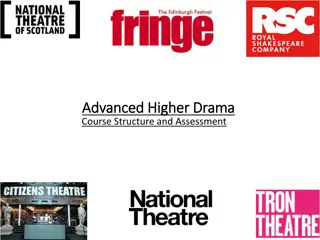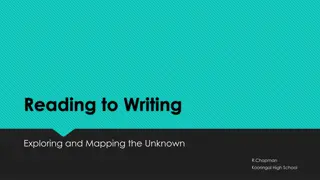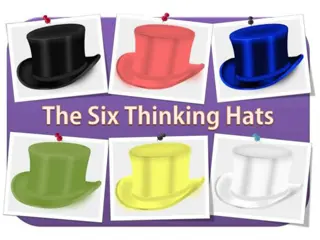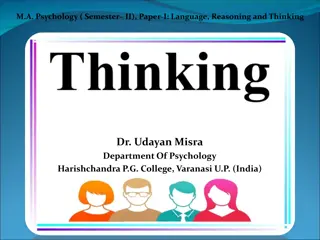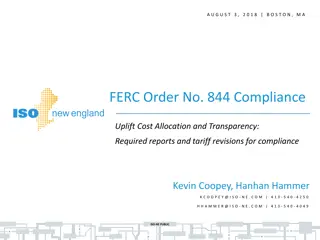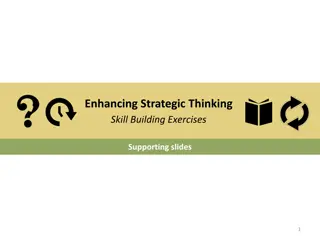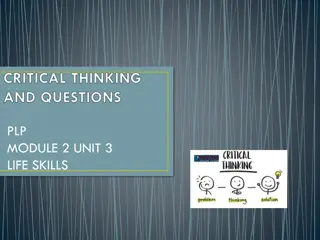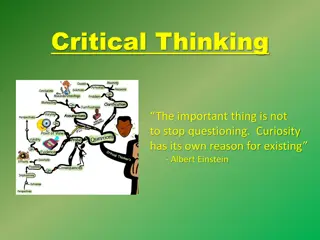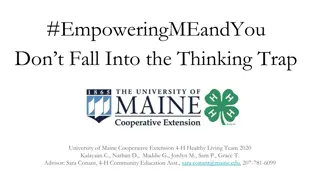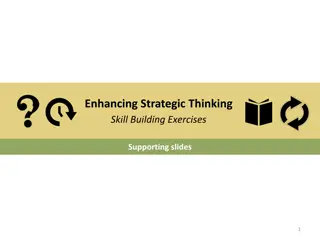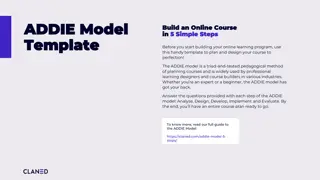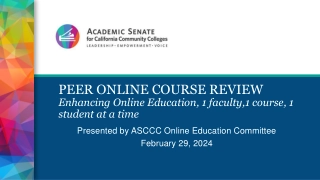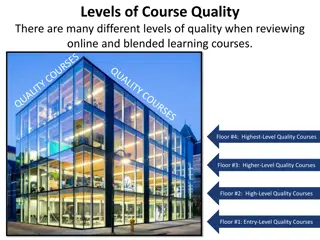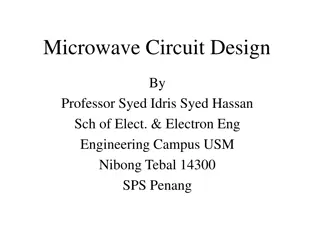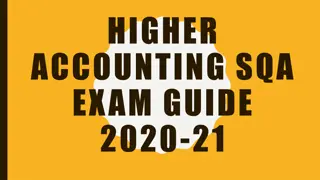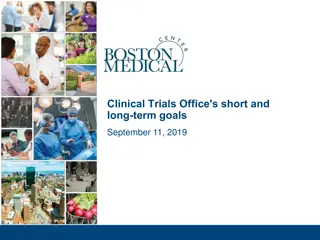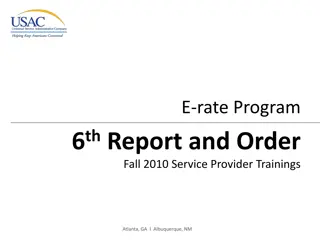Higher Order Thinking Series Course Design and Redesign - Fall 2010
Essential course elements like course description, student learning outcomes, assessment methods, and more are discussed in this Higher Order Thinking Series Course Design and Redesign session. The course aims to provide a foundation in human physiology for future professional studies, with specific measurable student outcomes outlined. Methods for assessing student learning performance are highlighted, emphasizing case studies, examinations, simulations, and more.
Download Presentation

Please find below an Image/Link to download the presentation.
The content on the website is provided AS IS for your information and personal use only. It may not be sold, licensed, or shared on other websites without obtaining consent from the author. Download presentation by click this link. If you encounter any issues during the download, it is possible that the publisher has removed the file from their server.
E N D
Presentation Transcript
Center for Learning and Development Higher Order Thinking Series Course Design and Redesign Fall 2010
Course Design/Redesign: I want to know
Additional Items Essential course elements: Course description Measurable student learning outcomes Assessment and grading Course requirements and schedule Instructional strategies Resources
Essential Course Elements Pt. I Goal (broad, abstract) What do you want to accomplish? Example: The goal of this course is to provide students with the fundamental knowledge of human physiology that will serve as an essential foundation for their future professional studies. Measurable Student Learning Outcomes/Objectives (SLO s) (specific, able to be validated) What are the students doing (specifically) to accomplish this goal? Example: Students will perform clinical scenarios to correlate basic physiology with the pathophysiologic outcomes they may encounter in the clinical setting.
Goal SLO Statement 1. Describe the legal basis of health services. 2. Introduce multidisciplinary fields of inquiry. 3. Demonstrate leadership skills. 4. Feel a sense of fellowship with fellow classmates. 5. Prepare learners for future study in biomechanics. 6. Differentiate between proper and improper diagnoses. 7. Provide a foundation for examining policy perspectives. 8. Create a treatment plan. 9. 10.
Goal SLO Statement 1. Describe the legal basis of health services. 2. Introduce multidisciplinary fields of inquiry. 3. Demonstrate leadership skills. 4. Feel a sense of fellowship with fellow classmates. 5. Prepare learners for future study in biomechanics. 6. Differentiate between proper and improper diagnoses. 7. Provide a foundation for examining policy perspectives. 8. Create a treatment plan. 9. Goal for your course 10. SLO for your course
Essential Course Elements Pt. II Methods of assessing student learning Performance Measures: How will the SLO s will be measured? Case studies Direct observation Examinations Multiple choice Short answer Essay Oral questioning Surveys Simulations Portfolios Presentations Self assessments Performance projects Rubrics Checklists Response Rate Assessment Surveys
Goal SLO Statement Performance Measure 1. Describe the legal basis of health services. x 2. Introduce multidisciplinary fields of inquiry. x 3. Demonstrate leadership skills. x 4. Feel a sense of fellowship with fellow classmates. x 5. Prepare learners for future study in biomechanics. x 6. Differentiate between proper and improper diagnoses. x 7. Provide a foundation for examining policy perspectives. x 8. Create a treatment plan. x 9. Goal for your course x 10. SLO for your course x
Essential Course Elements Pt. III Grading policy Inherent Targets Benchmarks for success: What constitutes success? Example: All students will achieve 80% mastery on their clinical scenario performance project. Course requirements Expectations for academic and social behavior Academic integrity, attendance, tardiness, group work, behavior, accountability, etc. Tentative Schedule of topics, instructors, dates, assignments Feedback mechanisms Revision opportunities
Sample Course Syllabi Rubric Element Exceeds Expectations Meets Expectations Does Not Meet Expectations Course description Provides context for learning and rationale for course. Outlines key concepts, topics, and/or skills to be covered. Indicates course s role in department/degree curriculum. Describes topics to be covered. Does not describe major skills or concepts. Does not link course to competencies or overarching goals. Describes course s major areas of inquiry. Outlines key concepts, topics, and/or skills to be covered. Provides context for learning and rationale for course. Indicates course s role in department/degree curriculum. Student learning outcomes Are measurable and/or observable. Progress toward more ambitious and rigorous higher order thinking skills. Are anchored by verbs describing what the student will do to provide evidence of mastery. Are grounded in departmental and/or school-wide competencies. Are measurable and/or observable. Describe desired behaviors that students will perform to demonstrate skill/concept mastery in the course. Involve cognitive challenge and higher-order thinking skills. Are not measurable or observable. Do not describe behaviors that students will perform in order to demonstrate higher order thinking. May describe content to be covered rather than student learning outcomes. Assessment and grading policy Thoroughly describes each assignment. Describes grading policy and philosophy clearly and concretely. Expectations for all forms of assessment (e.g., assignments, exams, group projects, etc.) are clear. Describes all assignments. Grading policy is defined, and point s distribution is explained. Assessments are not defined. Grading policy is either not explained or is defined in vague terms. Course requirements Clearly and thoroughly outlines requirements for success in course. Specifically and concretely describes all expectations for academic and social behavior. Details policies related to lateness, attendance, group work, citations, etc. Clearly outlines expectations related to class participation, group work, assignments, etc. Defines policies related to lateness, attendance, group work, citations, etc. Describes expectations in general terms (e.g., You should come to class prepared ). Does not specify course policies. Course schedule Lists learning objective(s) for each week in addition to topics. Cites related readings, both required and supplementary, for each week and any relevant assignments due. Lists topics and learning objectives to be covered each week. Identifies required readings and any relevant assignments due. May list topics to be covered but does not specify a schedule for learning.
The Big Picture 3 major questions to ask yourself when designing a course: Where are we going? How will we know when we have arrived? How will we get there? Goals & Objectives Assessment Instructional Strategy
Significant Learning Outcomes Continuously align and improve course components to maximize significant learning Engaging Learning Activities Informative Learning Assessment Situational Factors
Strategy/Activity Planning Sheet Goal SLO Assessment Instructional Strategies/Activities Content/ Resources
Do they align? SLO Name the 5 types of white blood cells in peripheral blood. Assessment Multiple-choice quiz Strategy Demonstration to learner of each cell type on stained blood film.
Do they align? Objective Evaluate/interpret given patient blood cell differential reports and conclude each report to be consistent or inconsistent with a specific cited pathological condition. Assessment Patient reports for students to determine whether each is consistent with a pathological condition and provide rationale Strategy Learner views videotapes detailing protocols for treatment of disorders.
Five Principles of Good Course Design 1. Challenges students to higher order learning. 2. Uses active forms of learning. 3. Gives frequent and immediate feedback to students on the quality of their learning. 4. Uses a structured sequence of different learning activities. 5. Has a fair system for assessing and grading students.
Active Learning Passive Learning Receiving information & ideas Experience Dialog Doing Self Observing Others
Higher Order & Active Learning Rich Learning Experiences In-depth Reflective Dialogue
Instructional Strategies Case study Problem-based learning Experiential learning Simulation; role playing Debate & discussion Journaling Collaborative learning http://www.utexas.edu/academic/ctl/criticalthinking/#Explore/Tags/holleranListening
Strategy/Activity Planning Sheet Goal SLO Assessment Instructional Strategies/Activities Content/ Resources
Course Design/Redesign Resources UNTHSC SLO Generator: http://www.hsc.unt.edu/qep/slo.html UNT N-Gen Initiatives: http://qep.unt.edu/what_is_n- gen.html Planning Your Course: A Decision Guide http://www.ohio.edu/gened/help/loader.cfm?url=/co mmonspot/security/getfile.cfm&PageID=13950 Duke University Faculty Development Module on Curriculum Design http://cfmmodules.mc.duke.edu/curriculum/index.htm l
Contact Information: Christine Savi, PhD Kun Huang, MEd Location: LIB-448 Phone: 817.735.2970 Email: catherine.mobley@unthsc.edu Website: http://www.hsc.unt.edu/qep/index.cfm



